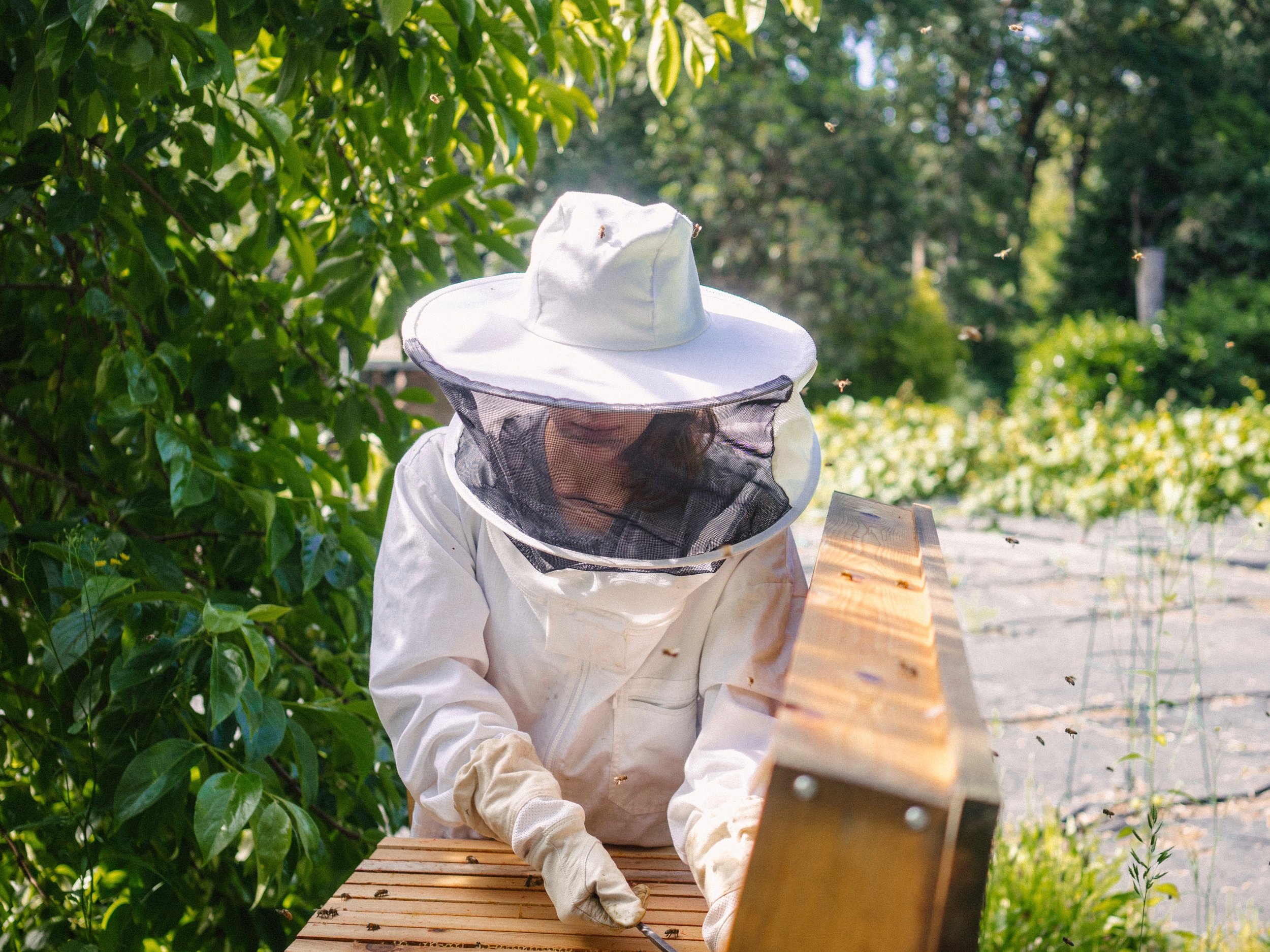2006 was a bad year for honeybees. According to Oregon State University, 30% of North America’s managed colonies perished that year. Those unprecedented losses catapulted bees into the public eye and highlighted their important role in the natural world. As shocking as those losses were, this tragedy has repeated every year since, cementing “Save the Bees” as one of the most popular activist campaigns of the 21st century.
Honeybees were brought to North America by European explorers in the 1600s to produce the liquid gold known as honey. It wasn’t until the rise of monoculture at the turn of the last century, that their sophisticated foraging behaviors were co-opted for commercial pollination services. Today, European honeybees are responsible for the successful fruiting of over one third of our produce. Before this shift, North American crop and food production relied on the services of our 4,000 native bee species (who are arguably better suited to the task).
It is true that honeybees are a more convenient commercial pollinator, but in relying solely upon them for our agricultural needs, we have put our food production system in a tenuous position with no safeguards. The very system that threatens our honeybees is also threatened by their decline. We need to adapt agricultural practices to support native pollinators, and move honeybee keeping back to a smaller scale. That’s where you come in!
AM I A BEEKEEPER?
As any beekeeper will attest, having a big buzzing superorganism in your backyard bestows certain benefits. The intelligence that bees display on any given day is at once fascinating and humbling, the productivity inspiring and the overall experience surprisingly fulfilling. What’s more, between honey and beeswax, you’ll have gifts for every occasion (though it is important to keep in mind that most people do not get excess honey or wax to harvest in their first year). You may even find yourself revered as the quirky neighborhood badass! That being said, responsible beekeeping requires a commitment, and therefore may not be for everyone.
If you are looking to promote healthy bee populations and improve pollination in your community, there are many other ways to help without starting a hive. Some examples include:
Planting native flowers
Growing your own organic food
Purchasing organic and local whenever possible
Purchasing honey from local beekeepers
Abstaining from the use of harsh chemicals to battle pests and weeds
Providing native bee habitats (check out the Xerces Society for more about this approach!)
Still thinking about honeybees? Let’s continue.

HOW MUCH WORK IS A BEEHIVE?
Honeybees are not completely domesticated, meaning that unlike your fearsome corgi, they do not require human support to survive. In fact, there are many feral colonies thriving in places like tree hollows without any human intervention. Still, managed honeybee colonies require good stewardship (especially in urban environments), which takes both time and knowledge.
Base-level beekeeping requires periodic inspections during the warm months to make sure your queen is laying eggs, your workers are building up honey stores, your colony has enough space to expand appropriately, and your hive is not pest or disease-ridden.
In the cold months, the colony clusters and eats through their honey stores, only emerging for “cleansing flights” on the warmest of days. Beekeepers do not inspect hives at this time of year to prevent hemorrhaging precious heat.
Management time and style will depend on your climate, your hive type, and your particular bees. All colonies are unique, and each beekeeper will have a different experience. For a baseline estimate, you can plan on 15 - 20 minutes per hive every week or two in the spring, summer and early fall.

BEEKEEPING IS LOCAL
There are no bees without blooms and no blooms without bees. Bees are florivores, which simply means they get all of their food from flowers. Their activity levels and colony populations directly coincide with the amount of flowers in bloom at any given time. Thus, honeybee seasons will vary across climates.
The easiest way to familiarize yourself with the timing of the beekeeping season in your area is to connect with other local beekeepers and beekeeping groups specific to your climate. For those of us in the Pacific Northwest, honeybee hives can be started anytime between late March and early June depending on the source of bees.
Beekeeping is quickly becoming a very popular backyard hobby, and as a result, obtaining bees and a hive can be difficult after January. Do your research, reserve your bees, and obtain all of the necessary equipment as far ahead of time as possible.

RESOURCES TO START WITH
Beekeeping is dynamic, requiring flexibility to respond to a wide range of scenarios. It is your responsibility as a beekeeper to never stop learning! Pick up a book or two about beekeeping practices and bee biology. Arm yourself with an arsenal of knowledge to become the best bee steward possible!
Below are some of our favorite books to start out with. If you have already chosen a hive style, begin by reading a book geared toward that particular hive. If not, you can start with a more generalized approach!
The Practical Beekeeper Series by Michael Bush
Top-Bar Beekeeping by Les Crowder
Sustainable Beekeeping with the Warre Hive by David Heaf
Honeybee Democracy by Thomas Seeley
We also recommend checking out these honeybee documentaries:
More than Honey
Vanishing of the Bees
Silence of the Bees
